How farms are structured in the EU has become the focus of increasing attention as a result of growing political concern over trends in farm consolidation and farmland concentration. This political interest has focused on different elements of structural change in EU agriculture. For some, the focus has been on land grabbing and the rise of large-scale land deals; for others, it is safeguarding the position of the family farm; for some, it is opposition to industrial farming and the growth of ‘mega’ farms; for others, it is defence of small farms, often seen as integral to food sovereignty; for some, the issue is generational renewal; while yet others focus on the decline in the overall number of farms. Common to all is the view that current patterns of farm structural change should be halted or even reversed.
Interestingly, this view is at variance with the objectives set out for the Common Agricultural Policy (CAP) in the Treaty of Rome and repeated in the Treaty on the Functioning of the European Union. This makes clear that facilitating structural change is an objective of the CAP, as a way of ensuring a fair standard of living for the agricultural community and increasing the individual earnings of persons engaged in agriculture (the Treaty language speaks of “ensuring the rational development of agricultural production and the optimum utilisation of the factors of production, in particular labour”).
Nonetheless, concern over the pace of structural change was forcefully articulated by the current Commissioner for Agriculture and Rural Development Janusz Wojciechowski during his first confirmation hearing before the AGRI Committee of the European Parliament in October 2019 when he stated:
During the presentation of my report about the Young Farmers’ Scheme in this committee, I presented the shocking information – shocking at least for some audiences – that during one decade, from 2005 to 2015, we lost four million farms in the European Union. The number of farms was almost 15 million, and after a decade there were fewer than 11 million farms. If we lose four million per decade, it is 400 000 per year. More than 30 000 per month. More than 1 000 per day. Our debate is scheduled to last three hours, which means that during this debate more than 100 European farmers will probably lose their farm and their job. For many of them it will be a tragic, shocking situation because it not so easy to be a farmer today and then tomorrow to do something different – to be a taxi driver, for example. In many cases, this is a dramatic situation for European farmers.
The most comprehensive recent survey of structural change in EU agriculture is this 2016 paper by Laurent Piet of INRAE which examines changes in the distribution of farmland area, complemented by a later paper in 2017 which analyses changes in the distribution of production across farms. The European Parliament Policy Department also published a report in 2016 containing two papers describing farm structural change in Western Europe, and in Central and Eastern Europe, respectively. These papers relied on the latest data available to them which was the 2013 Farm Structure Survey. In this post, I update parts of their analysis taking the most recent 2016 Farm Structure Survey into account.
Research into farm structural change
Descriptions of farm structural change have focused on two related but distinct dimensions. One is the degree of inequality in the distribution of farmland (or production or livestock numbers or whatever is the structural variable of interest) and whether this is changing over time. In industrial economics, this gives rise to an interest in market structure, i.e. the size distribution of firms.
One line of inquiry has focused on the relationship between firm size and growth. The economist Robert Gibrat investigated French manufacturing firms in 1931 and concluded that firm growth is a random effect, independent of firm size. That is, small firms are as likely to grow at the same rate as large firms. This idea is known as Gibrat’s law or the law of proportionate effect.
Whether this relationship holds between farm size and growth has been tested in papers by Štefan Bojnec, Imre Fertö and colleagues for crop and dairy farms in France, Hungary and Slovenia, and for all farms in Slovenia. The former paper found evidence that smaller farms grew faster than larger farms (implying a reduction in farm size inequality) in the first decade of the 21st century, while the Slovenian paper found farms in all size groups growing at a similar rate and contributing to an increase in average farm size.
The farm size distribution (often measured using the Gini coefficient) is a relative measure of overall inequality and thus fails to completely capture concentration effects, in the form of shifts of production to fewer but larger farms. Piet (2016) gives the following example to illustrate the difference between changes in size distribution and changes in concentration. A hypothetical 1,000 ha region/country ‘A’ with 2 farms, one sized 200 hectares and the other sized 800 hectares, will exhibit the same Gini coefficient as another hypothetical 1,000 ha region/ country ‘B’ with 100 farms, 50 of which operate 4 hectares each and the other 50 operating 16 hectares each. Despite the same levels of relative inequality, farmland is much more concentrated in country ‘A’.
The mean or median of the distribution can give an indication of the degree of concentration (in the previous example, the mean farm size in country ‘A’ is 500 ha and in country ‘B’ it is 10 ha, confirming that farmland is more concentrated in country ‘A’). However, while the mean and median are useful measures of central tendency in relatively symmetric distributions, they are much less informative when distributions are highly skewed.
In this situation, a preferred measure is the mid-point size or the hectare-weighted median. The hectare-weighted median corresponds to a farm size that separates the farm size distribution into two parts: 50% of the total area of the national farmland is operated by the farms of a larger size and the other 50% by farms of smaller size than the hectare-weighted median. The mid-point size provides a better indication of the holding size from which the typical unit of agricultural production originates. It is less sensitive to the presence of a large number of small farms that use a minor part of agricultural land. It has the further advantage that it is much less sensitive to changes in the definition of the farm population (for example, if there is a change in the minimum size threshold in defining a farm). The higher the mid-point size, the greater the degree of land concentration. I previously used the mid-point size to discuss the changing structure of the EU dairy industry in this post.
Changes in the extent of farmland concentration over time can be the result either of a reduction in the number of farms or a change in the distribution of farm sizes or both. Piet in his 2017 paper provides a methodology to make this decomposition. Indirect evidence can be provided by comparing the trend in the mean farm size with the trend in the mid-point size. The mid-point size growing faster than the mean size indicates a faster increase in the size of large-scale enterprises compared to small and medium-size farms and thus an increase in relative inequality, and vice versa.
Armed with this background, let us now examine what the data tell us.
Trends in the number of farms
The trend in EU farm numbers is shown in the following table for the period since 2005 (the UK is included in this table, but EU totals sometimes exclude Croatia due to the unavailability of 2005 data). The decline in the total number of farms, from around 15 million in 2005 to 10.5 million in 2016, is evident. Nonetheless, it is clear from the last column that country experiences have been very heterogeneous. Ireland stands out as having bucked the trend in falling farm numbers, even showing a small increase (4%) over the period. The fall in numbers in Slovenia and Spain has also been limited. At the other extreme, farm numbers in some of the newer Member States have fallen even more drastically: in Slovakia by -63%, in Bulgaria by -62%, in Latvia by -46%, in Poland by -43%, in Lithuania by -41%, in Estonia and Hungary by -40%.
Some of this fall in the farm population is due to changes in statistical coverage. Eurostat has published a methodological note that describes and analyses the impact of changes in the lower minimum threshold for defining a farm holding over time. Following the entry into force of Regulation (EC) No 1166/2008, the minimum requirements for survey coverage from the 2010 Farm Structure Survey onwards have been modified. For a few countries this had quite a dramatic effect. For example, the table below shows a fall in the number of Czech holdings between 2007 and 2010 of -42%. However, if the same thresholds were used in both years, the decrease in the number of holdings would only have been -4%. For Germany, the table below reports a decrease in total holdings of -19% between 2007 and 2010, whereas the fall would have been only -6% if the thresholds had remained unchanged. For Poland, the reported drop between these two years is -37%, whereas the drop would have been only -16% if the thresholds were not changed.
On the other hand, the change in definitions resulted in a small increase in the number of holdings reported in Denmark. Here the change between 2007 and 2010 in the table below is a fall of -7%, whereas it would have been a fall of -12% without the change in definitions. The change in thresholds in Italy in 2010 resulted in about 10% more holdings being included than would have occurred under the 2007 definitions. However, Italy raised the threshold again in 2013 which removed much of this increase.
On balance, more farms have been excluded by the changes in the minimum thresholds over time than have been included. This “statistical exit” accounts for some of the apparent reduction in farm numbers over time. It is of course not the whole story or even the dominant part of the story in measuring structural change. While the changing thresholds can have a significant impact on certain variables, such as the number of holdings, they have no impact on other variables such as agricultural area, agricultural output or livestock numbers given the way the thresholds are defined.
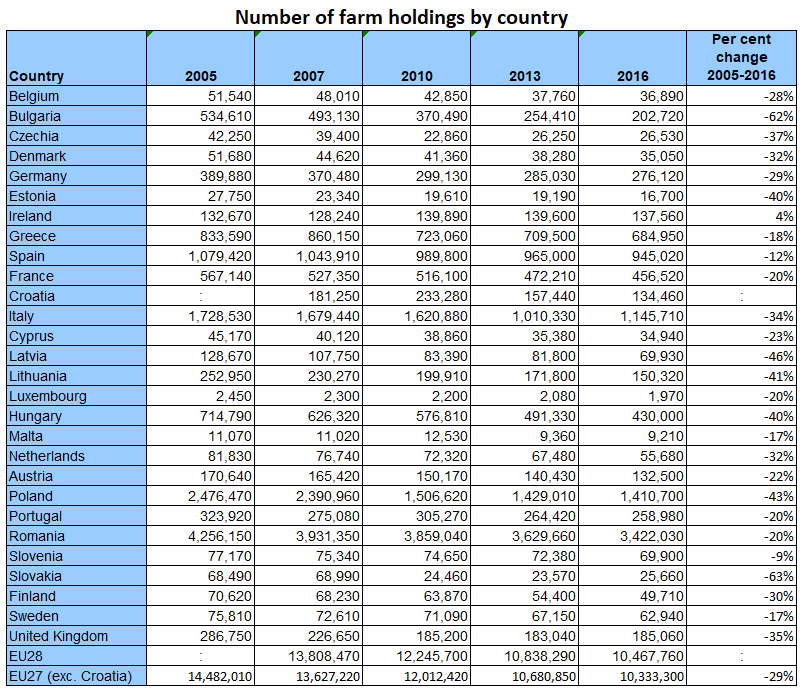
Share of farmland and agricultural output of largest farms
The next graph shows the distribution of farmland by the farm size groups determined by Eurostat in 2016. The most striking feature is that over half of all EU farmland is controlled by the 345,000 holdings over 100 ha in size. There is a striking inequality in the distribution of land by farm size. The policy implications of this skewed distribution are not always recognised. For example, for policies that focus on land management (e.g. nutrient use, biodiversity habitats, soil carbon sequestration) rather than, say, farm income, improving practices on these 3% of all farm holdings rather than the other 97% would go a long way to making a substantial difference to overall trends.
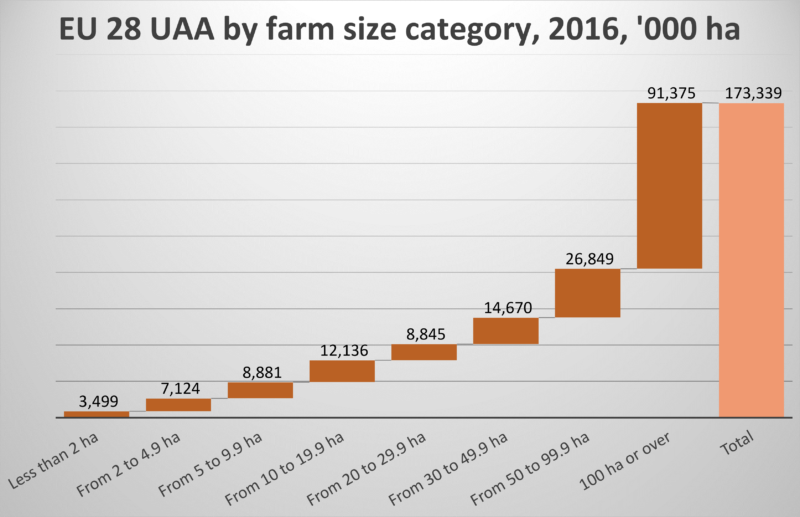
The distribution of agricultural output by farm size class is not quite so concentrated, reflecting the fact that smaller farms tend to use their land more intensively as well as concentrate on higher-value crops (fruits, vegetables, wine, olives) than larger farms. The share of the largest size class (100 ha and over) in total agricultural output in 2016 was 37%, compared to its share in area of 53%. Nonetheless, the chart below shows that this share has steadily grown over time, from 28% in 2005 to 37% in 2016.
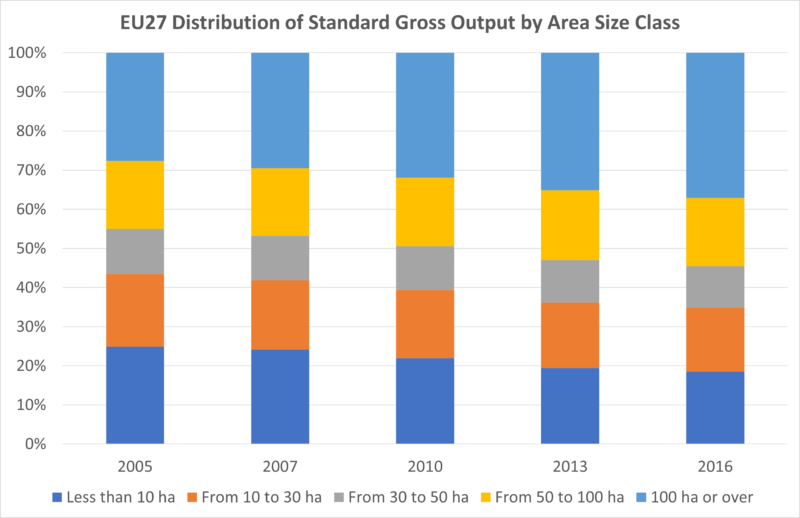
Growth in farm size over time
Farm consolidation is reflected in growth in average farm size. The previous discussion highlighted that looking at the change in average (mean) farm size can be misleading when the size distribution is very skewed and recommended using the mid-point size as a more informative indicator. The following table compares the trends in the mid-point size and the average farm size for older and newer Member States and for the entire EU. The method to derive the mid-point size estimates is described in a technical annex at the end of this post. The estimates are derived from grouped data and require some strong assumptions which are unlikely to hold in practice. Thus, the absolute mid-point size figures should be treated as approximate although the trends observed are likely accurate.

The figures confirm the conventional wisdom regarding farm size and farm consolidation. Average farm sizes are in general small. They are lower in the EU12 compared to the EU15. However, mid-point sizes are considerably larger. Thus, the ‘typical’ hectare was on a farm of 135 ha in the EU15 and a farm of 97 ha in the EU12 in 2016. Furthermore, farm consolidation has been taking place more rapidly in the newer Member States. The fact that mid-point sizes have been increasing more rapidly than average farm size in both the older and newer Member States indicates that both the reduction in the number of farms and an increase in farm size inequality have contributed to farm consolidation over the past decade.
However, these aggregations conceal much greater heterogeneity at the Member State level. The national figures are available in this spreadsheet, but the conclusions are summarised in the following table. Countries are divided vertically into ‘rapid consolidators’, ‘slow consolidators’ and ‘deconsolidators’. Countries are divided horizontally into those where the farm size distribution has become more equal, has remained unchanged (this is evaluated where the difference between the change in average size and mid-point size is less than 10 percentage points), or has become more unequal.
One reason for greater heterogeneity at the country level is greater variability in trends in the agricultural area. While this has been reasonably stable overall for the EU15 and EU12, some individual Member States report significant increases in agricultural area, for example, Bulgaria (+64%), Estonia (+20%), Ireland (+16%) and Greece (+14%). There are also Member States where the agricultural area has declined, for example, Austria (-18%) and Cyprus (-26%). These changes in the total area farmed have contrasting impacts on the trend in average and mid-point farm sizes.

Although farm consolidation has been the norm, its pace differs across countries and there are examples of deconcentration. These latter cases are all countries where very large farms are much more common (Bulgaria would also be part of this group were it not for the large reported increase in total agricultural area between 2007 and 2010, most of which was attributed to its largest holdings). This deconcentration reflects the gradual break-up and downsizing of very large holdings in these countries.
A second observation from the table above is that countries tend to lie along the diagonal. Farm consolidation in all the rapid consolidators is driven both by a fall in farm numbers as well as by increasing farm size inequality. In countries that have experienced slow or reverse consolidation, smaller farms have grown at least as fast as larger farms and farm size inequality has been either stable or decreasing. The exceptions to this rule are Ireland, Cyprus and Slovenia that are slow consolidators despite rising inequality. In the case of Ireland and Slovenia, this is explained by the relatively slow decline in farm numbers (indeed, in Ireland’s case, an increase), and in the case of Cyprus by a marked decline in the agricultural area which has slowed the reported rise in farm consolidation despite rising inequality.
Conclusions
There is increasing interest in trends in the size distribution of farms. The traditional view that structural change is desirable because it improves the overall competitiveness of the farm sector and helps to narrow the gap between farm and non-farm incomes is increasingly challenged by those who worry about the emergence of large-scale (‘industrial’) farms and by the disappearance of smaller farms and farmers. The quotation from Commissioner Wojciechowski at the beginning of the post picks up on this criticism.
This post does not take sides in this debate (my view is that farm numbers will and must continue to decline, but policy can help to strengthen the position of smaller farms by encouraging diversification while discouraging the emergence of very large concentrated holdings, recognising that history means that Member States have very different starting positions in this respect). Its purpose is to document the changes that are taking place and to highlight the heterogeneity of Member State experiences.
There are several conclusions from the previous analysis. One is to appeal to Eurostat to bring its structural statistics into the twenty-first century. It is no longer acceptable to publish structural statistics in which there is a detailed breakdown of farm sizes for farms on half of the utilised agricultural area (there are eight separate size categories shown for farms less than 100 hectares), and to lump all other farms into the 100 ha and over category. Now that the mid-point size for the EU is almost 130 hectares, Eurostat must get its act together and provide a much more detailed breakdown of the farm size distribution over 100 hectares which accounts for over half of agricultural land. DG AGRI has shown what can be done using CATS payments data as in the chart below which includes six size classes over 100 hectares including an ‘over 1,000 ha’ class (incidentally, this chart shows that CAP payments per hectare are on average lower on the largest farms, thus undermining the argument that the CAP is responsible for ongoing farm consolidation). So, please, Eurostat, make it your 2021 New Year’s resolution to step up to the mark and provide a more relevant classification of farm structure statistics.
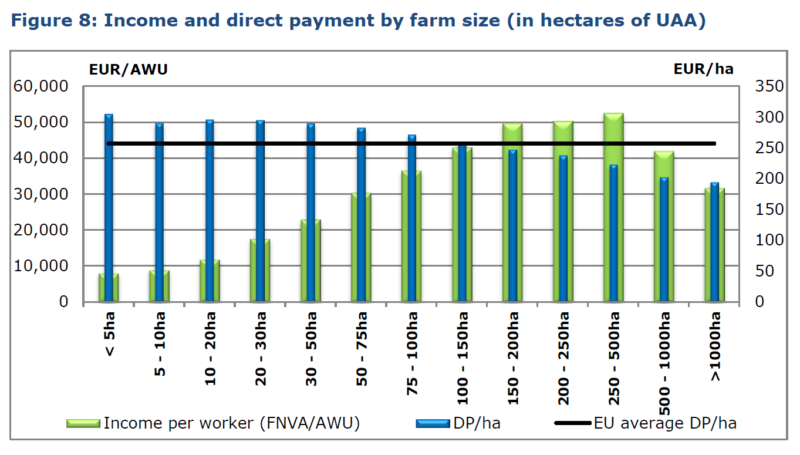
It is well established that the concentration of agricultural income support is driven by the concentration of land, as most direct payments are area-based payments granted per eligible hectare of land. A second conclusion is that as farm consolidation continues, the legitimacy of these payments intended as income support becomes increasingly tenuous. Converting these payments into public goods payments on these larger farms (as suggested in this post) would be entirely within the spirit of the European Green Deal.
Technical annex
Eurostat publishes farm size data by size class group. Following Loughrey et al (2017), estimating the mid-point hectare statistic firstly involves identifying the size class containing the median hectare i.e. the 50th percentile of the distribution and applying the following formula:
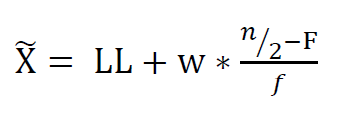
where X is the estimated median value, LL represents the lower limit for the median size class and w represents the width of the size class. For example, in the case of the interval for the category of five to ten hectares, the width of the interval w equals 5. n represents the total number of hectares in the population, F represents the cumulative distribution of hectares up to the lower limit (LL) of the median size class and f represents the number of hectares in the interval containing the median farm.
Previous papers using this statistic have not calculated a mid-point statistic where the size class containing the median hectare is in the ‘100 ha and above’ class which is the upper size class published by Eurostat. We make use of the fact that this formula assumes that hectares are equally distributed within a size class. We make the same assumption for the upper size class. Using this assumption, we create a new size class where the lower limit is 100 ha and the upper limit is the average size of farms in the ‘100 ha and over’ class. By virtue of this assumption, this size class contains exactly half of the hectares in the ‘100 ha and over’ class, which allows us to apply the formula above. The extent of the approximation involved in using this assumption can be tested by comparing our results for the mid-point size class in 2013 with those reported by Piet (2016) derived by statistically fitting a Lorenz curve to the grouped data. In general, there is a reasonable correspondence between the results but with marked differences for those countries with a very skewed distribution (Bulgaria, Czechia, Slovakia) where Piet’s mid-point sizes are much higher than those reported here.
This post was written by Alan Matthews
Photo credit: Alan Matthews, Melby, Denmark
Update 4 January 2021: The average farm size in Country B in the example above was corrected to 10 ha.

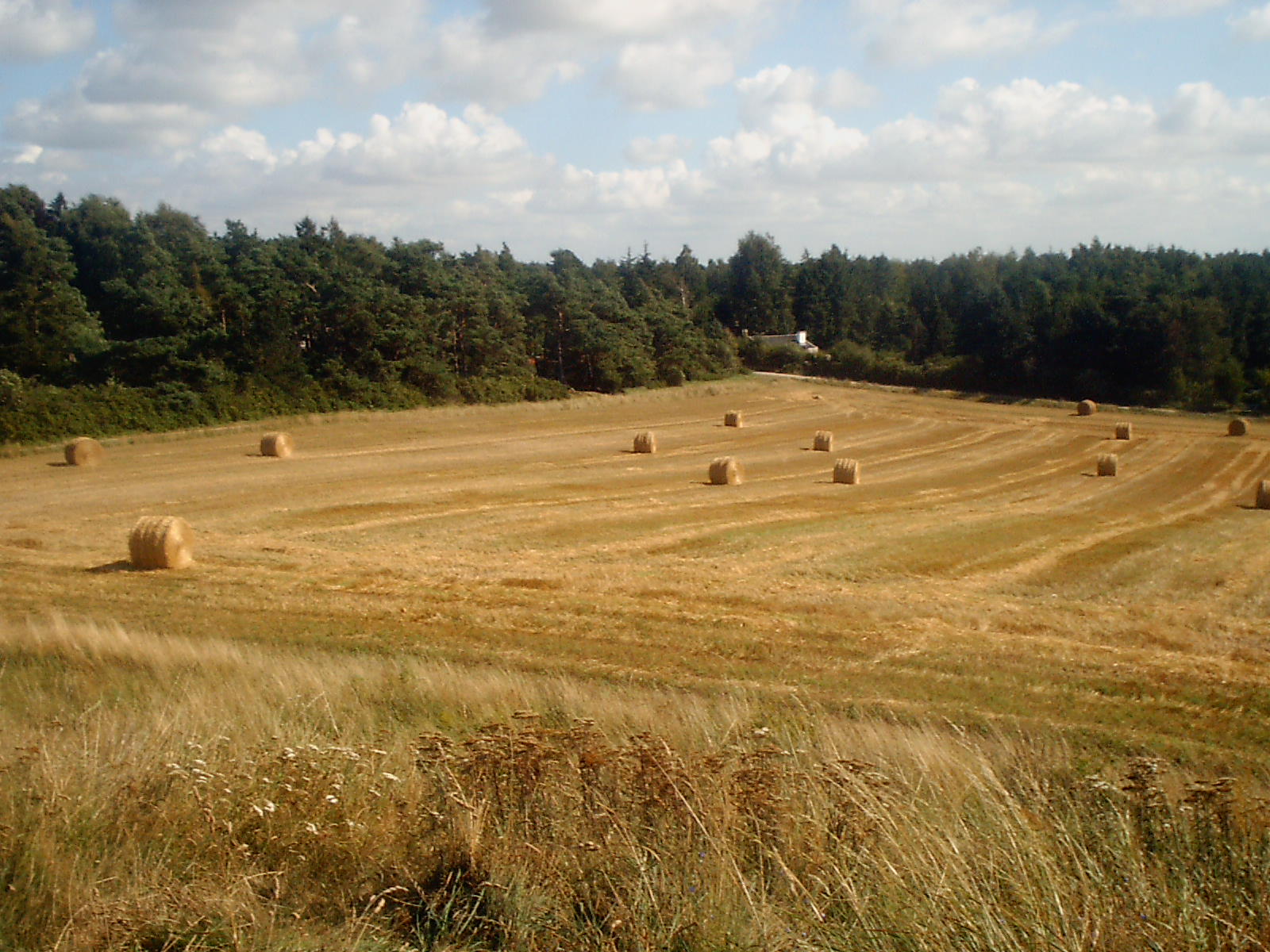

Another hugely important paper. It is only with analysis such as this that equitable agricultural policies across the EU, and the UK will be achieved. Other issues such as the social and food production benefits of smaller farms are also significant.